NextGen 2024: Genetics in SJIA Session Part 3
 AI Summary
AI Summary
Key Insights
- HLA-DRB1*15 is a common class II HLA allele group and a component of the common Eurasian ancestral haplotype.
- HLA-DRB1*15 carriage varies by geography and ancestry with varying rates across regions.
- HLA-DRB1*15 alleles are not associated with systemic juvenile idiopathic arthritis (sJIA) in both case-control populations and ImmunoChip studies.
- Still's-Lung Disease and Drug Reactions are associated with HLA-DRB1*15 alleles, with the majority of Still's-Lung Disease cases carrying HLA-DRB1*15.
- Coexistence of Lung Disease and Drug Reaction with shared HLA-DRB1*15 association suggests shared pathophysiology, but a specific mechanism remains unclear.
Loading...
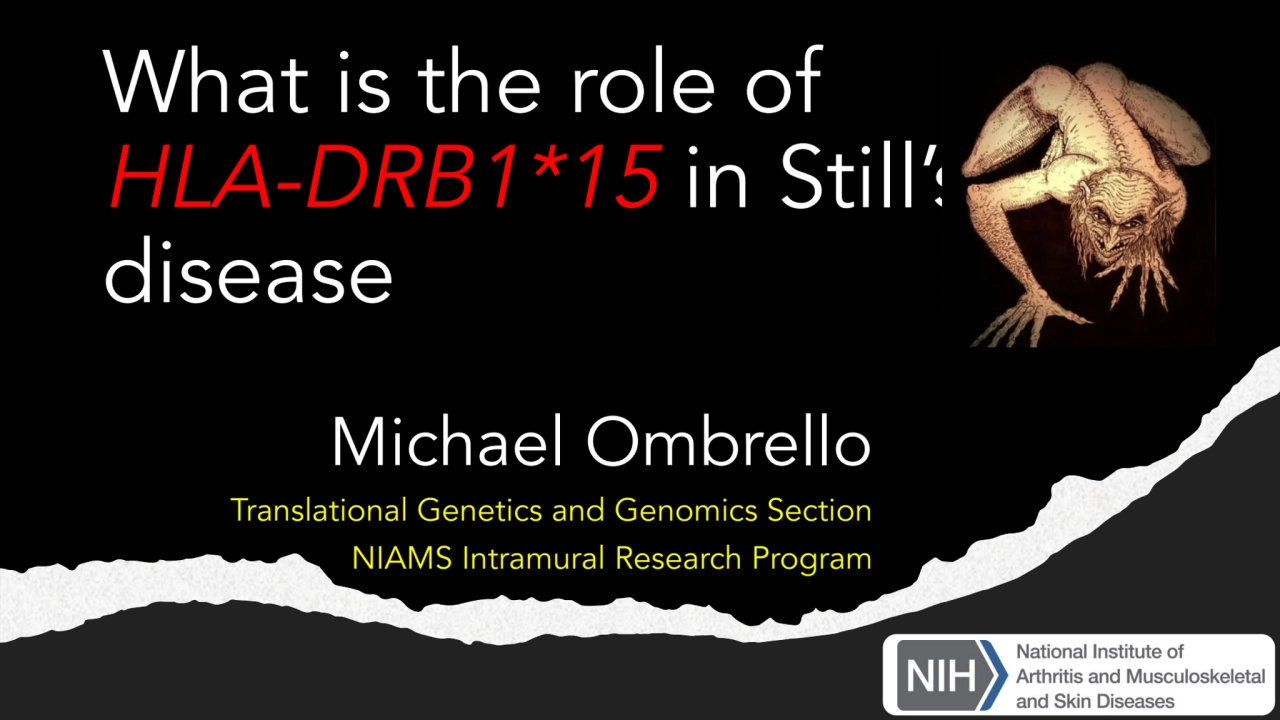
Loading...

Loading...
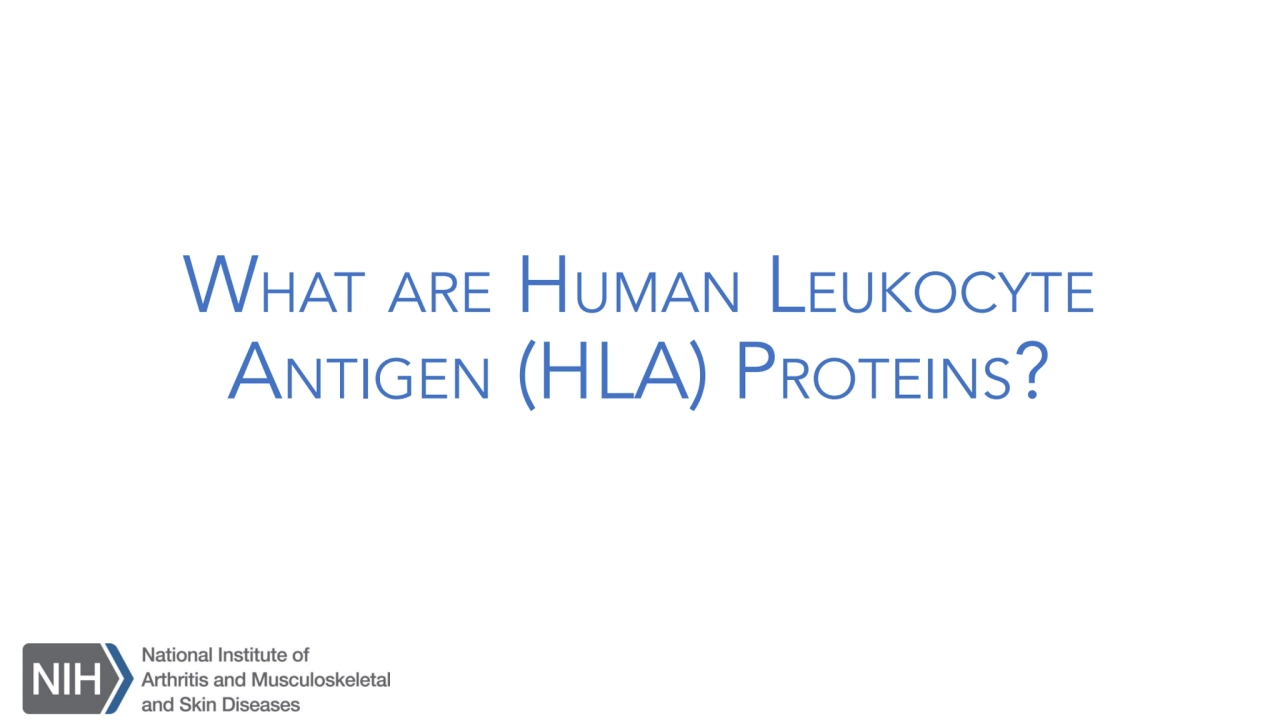
Loading...
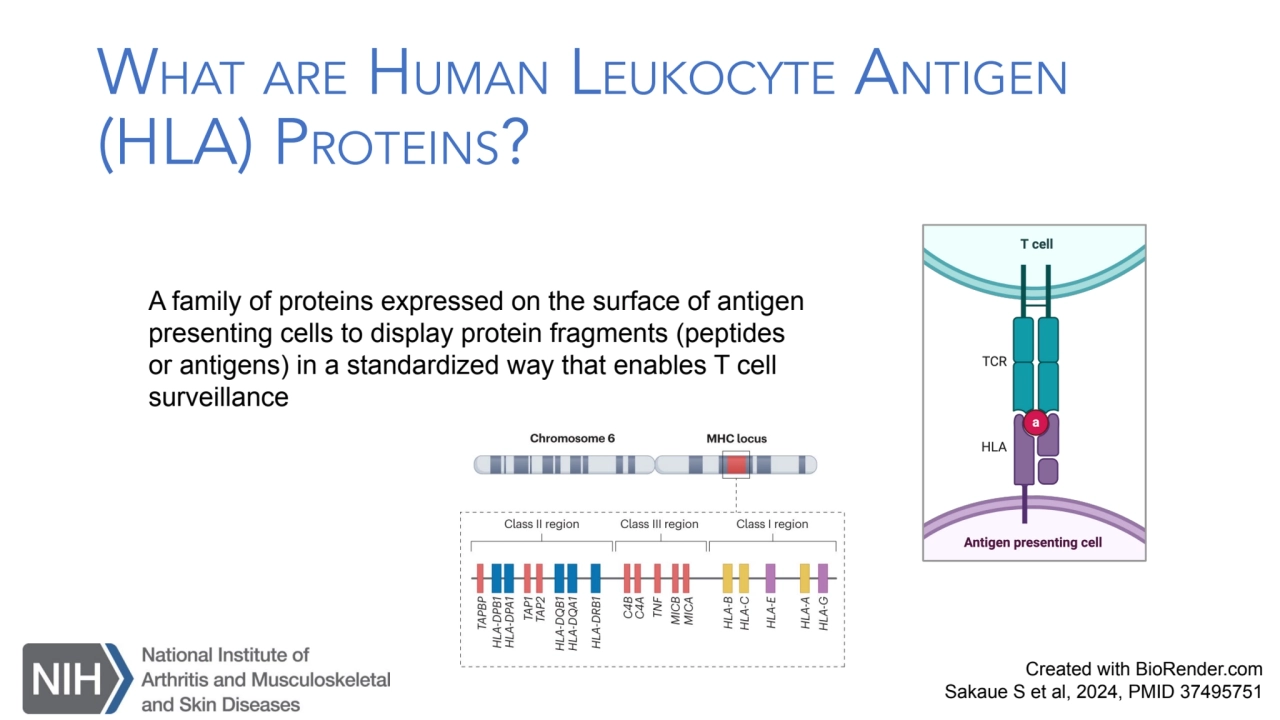
Loading...
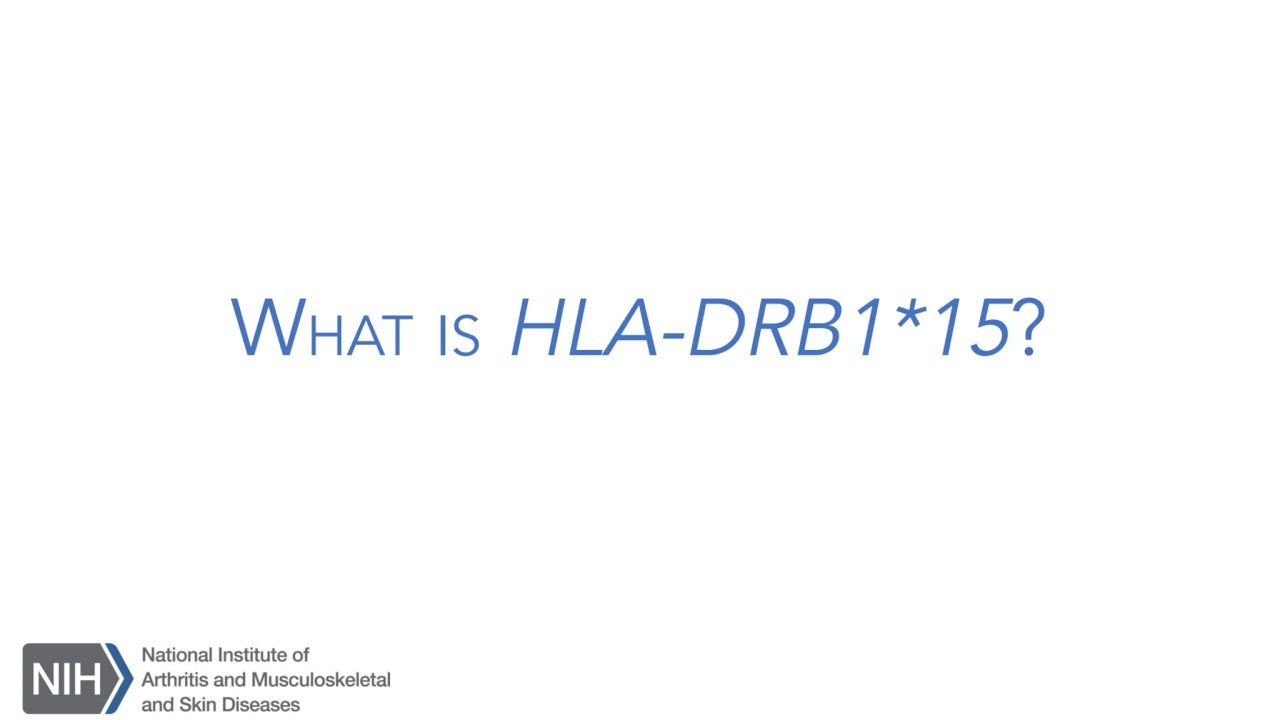
Loading...
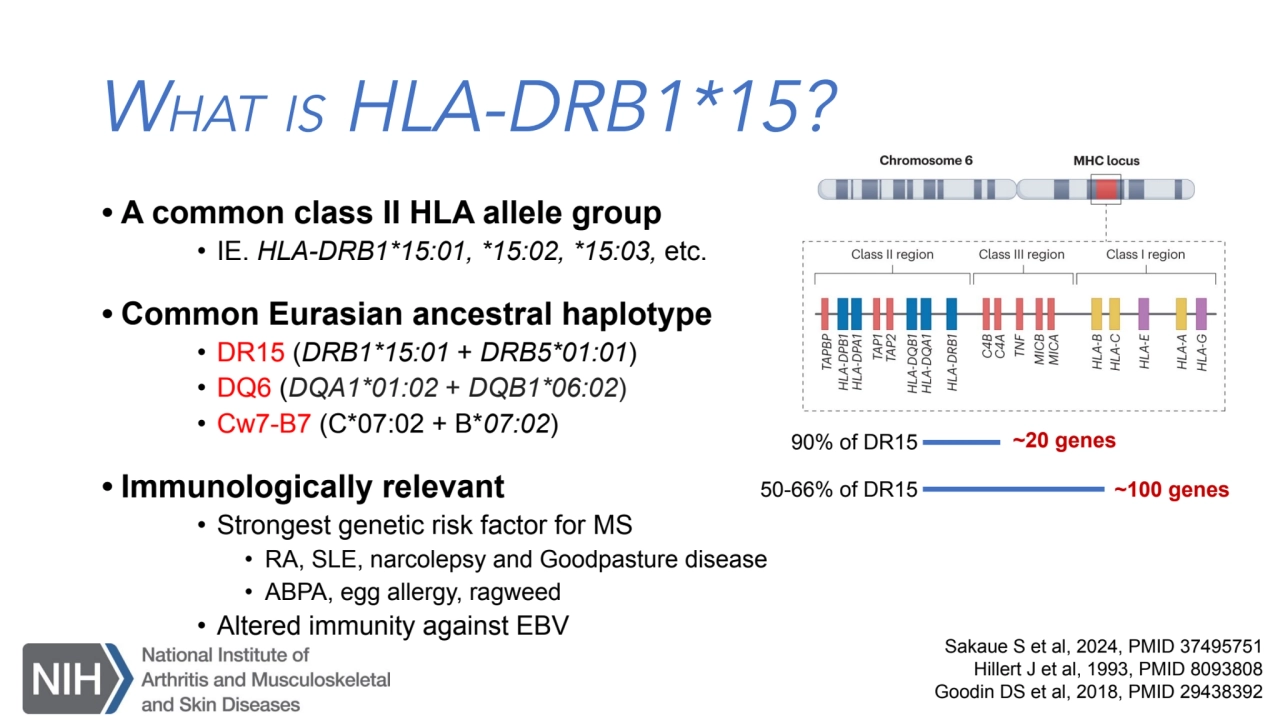
Loading...
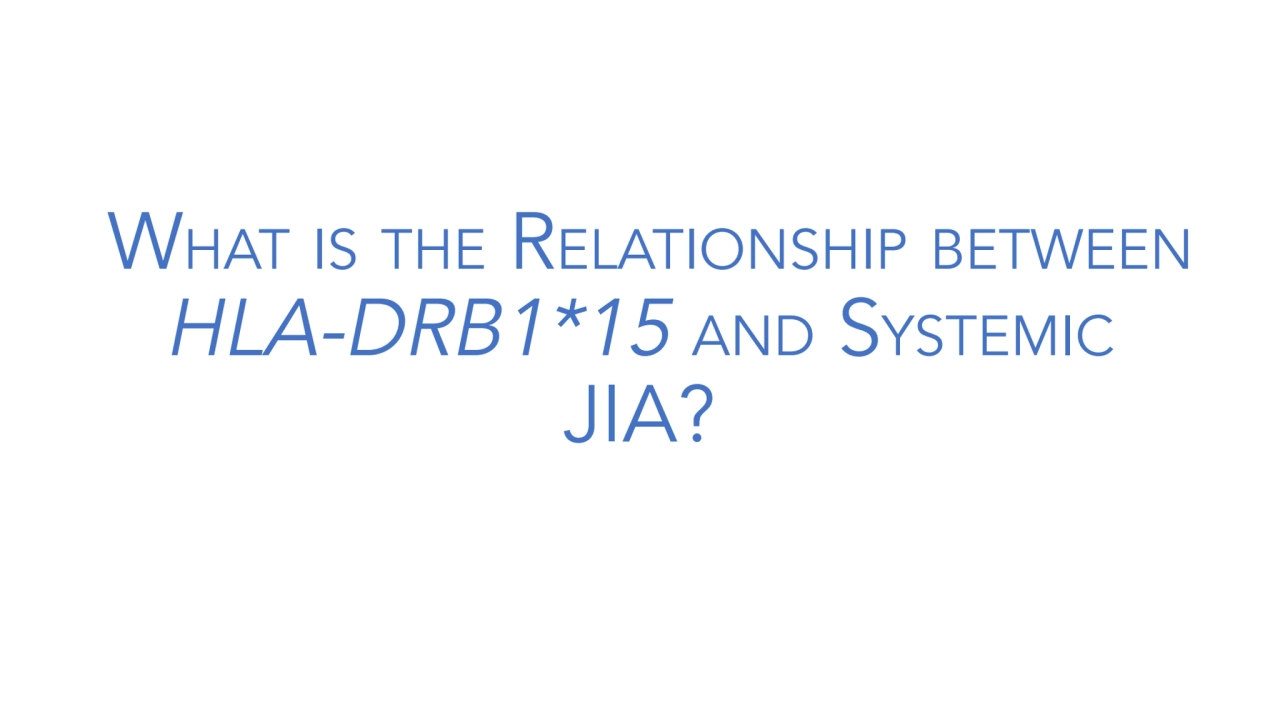
Loading...
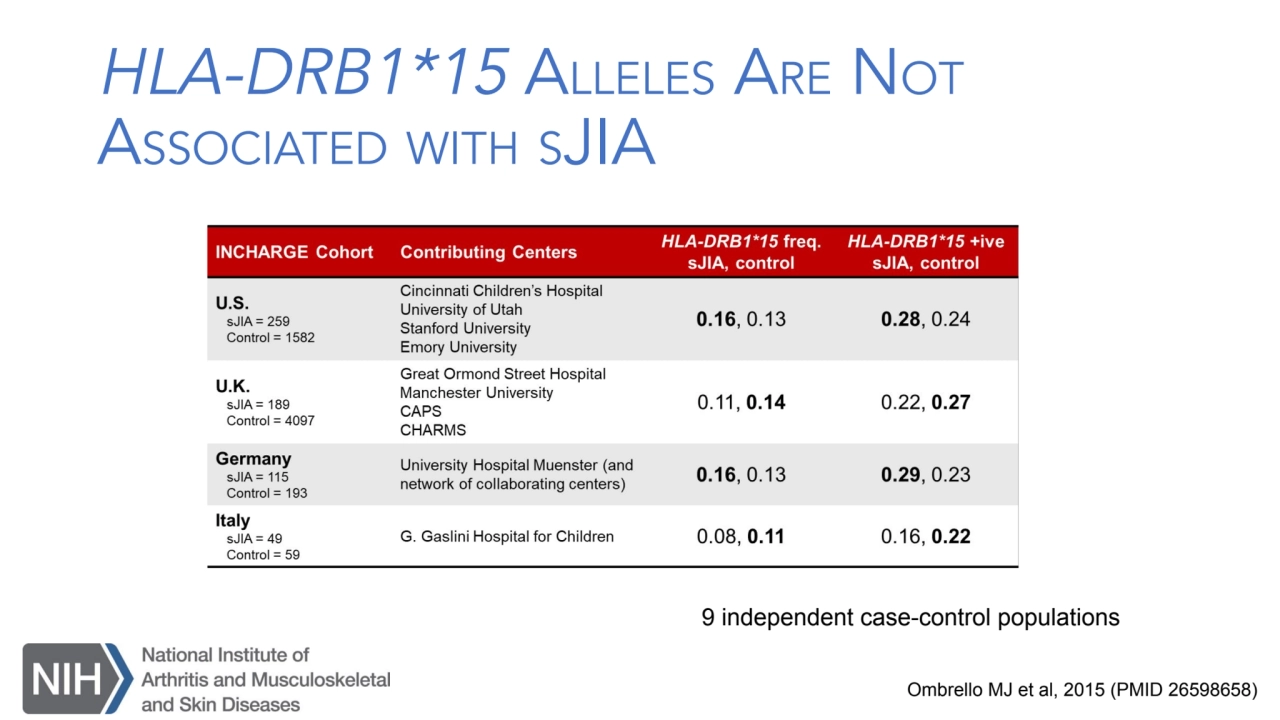
Loading...
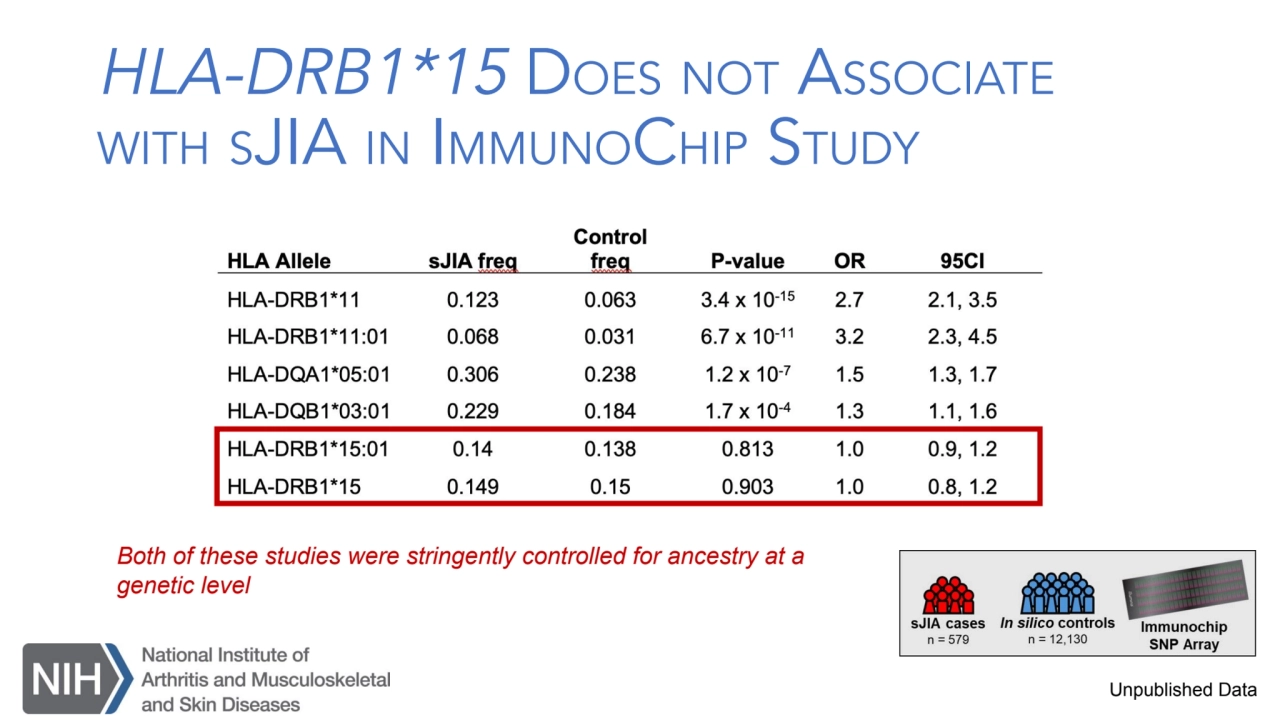
Loading...
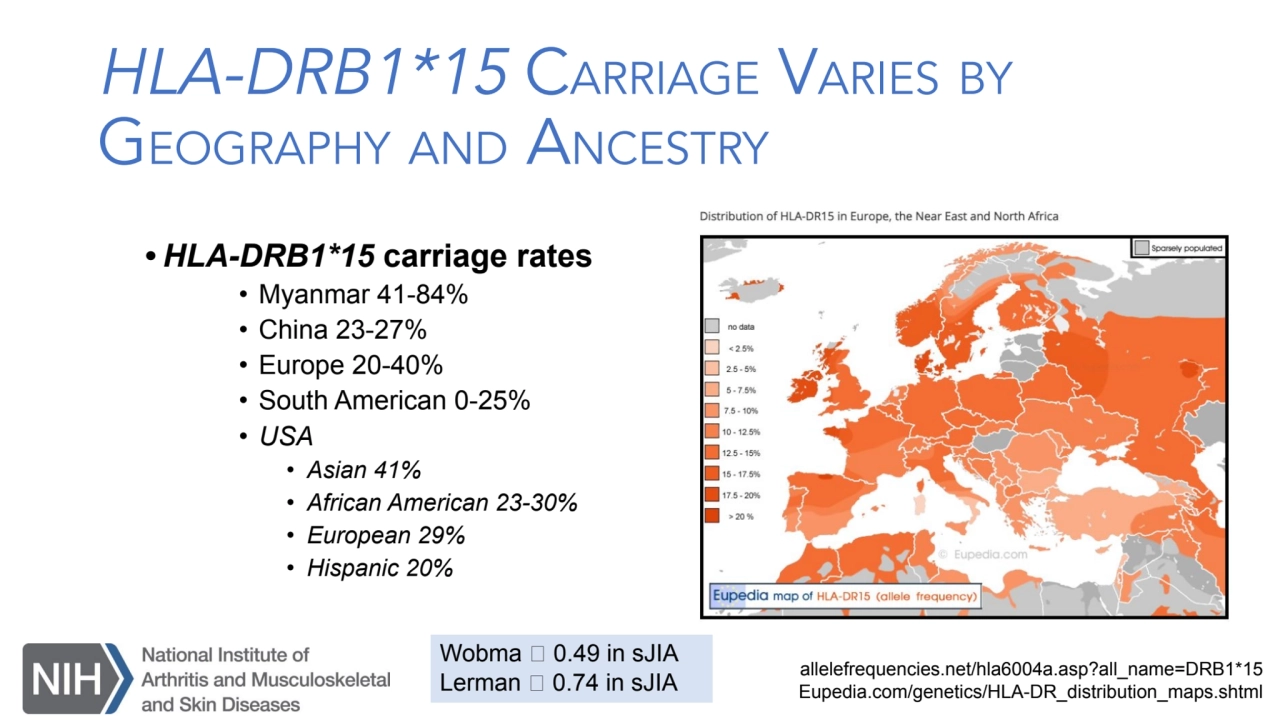
Loading...
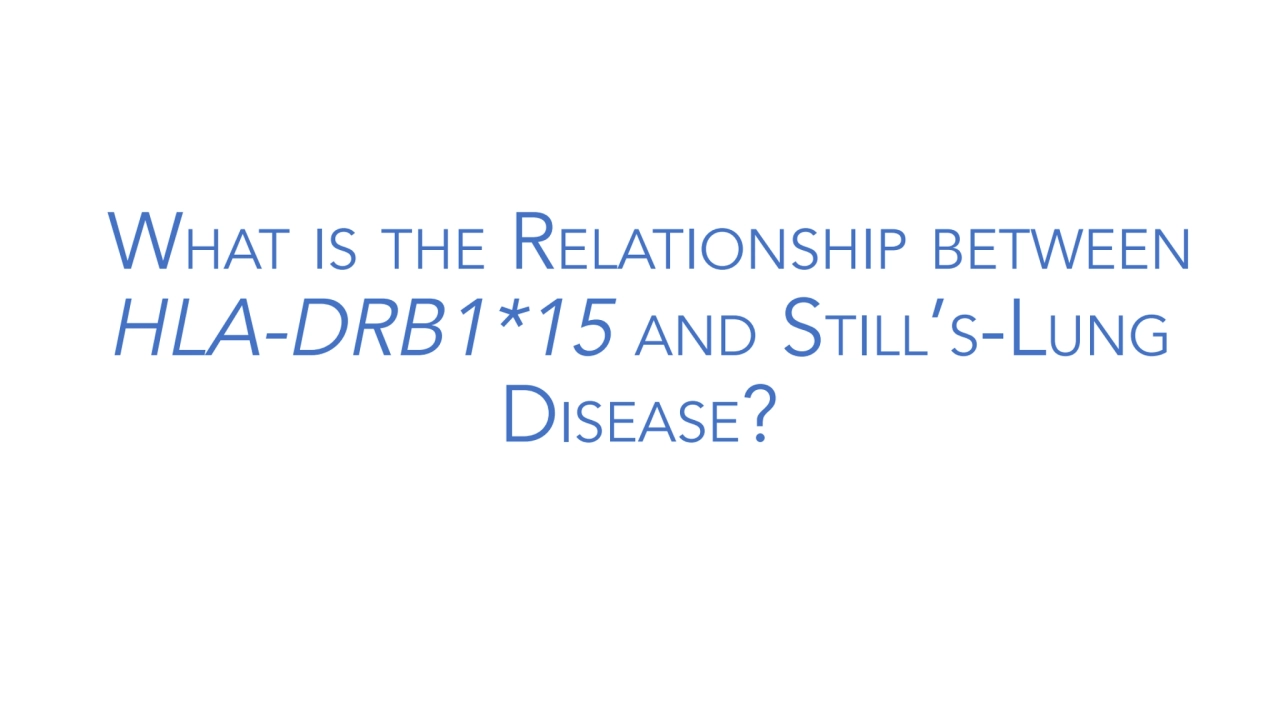
Loading...
![STILL’S-LUNG DISEASE IS ASSOCIATED WITH
HLA-DRB1*15 ALLELES
1. Still’s-LD carriage of HLA-DRB1*15 = 82%
2. Still’s-LD (n=47) vs. INCHARGE sJIA
• HLA-DRB1*15 had an OR of 14.1 [6.4, 31]
3. Still’s-LD (n=47) vs. “drug tolerant” sJIA (n=31)
• HLA-DRB1*15 had an OR 57.6 [11.5, 288]
Saper VS et al, 2022 Ann Rheum Dis](https://d2z384uprhdr6y.cloudfront.net/aI_R-GvVXZqL1hBf6ovmcsBH1jUnVVTQAuf32BoeszQ/rt:fill/q:100/w:1280/h:0/gravity:sm/czM6Ly9qYXVudC1wcm9kdWN0aW9uLXVwbG9hZHMvMjAyNC8xMi8wNS80MzczM2Y2NS04NzFlLTQzZjctYjFjYy1hYTBhYjkyYWQ2YWUvc2xpZGVfMTItbC53ZWJw.webp)
Loading...
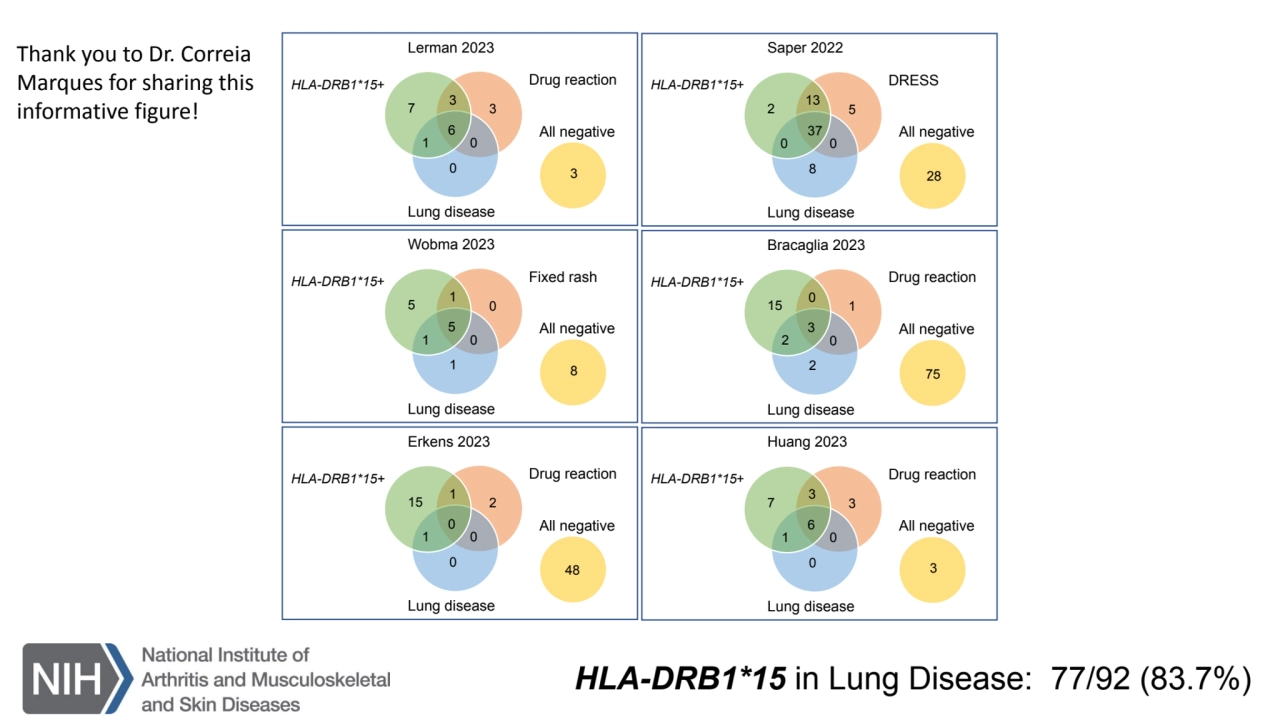
Loading...
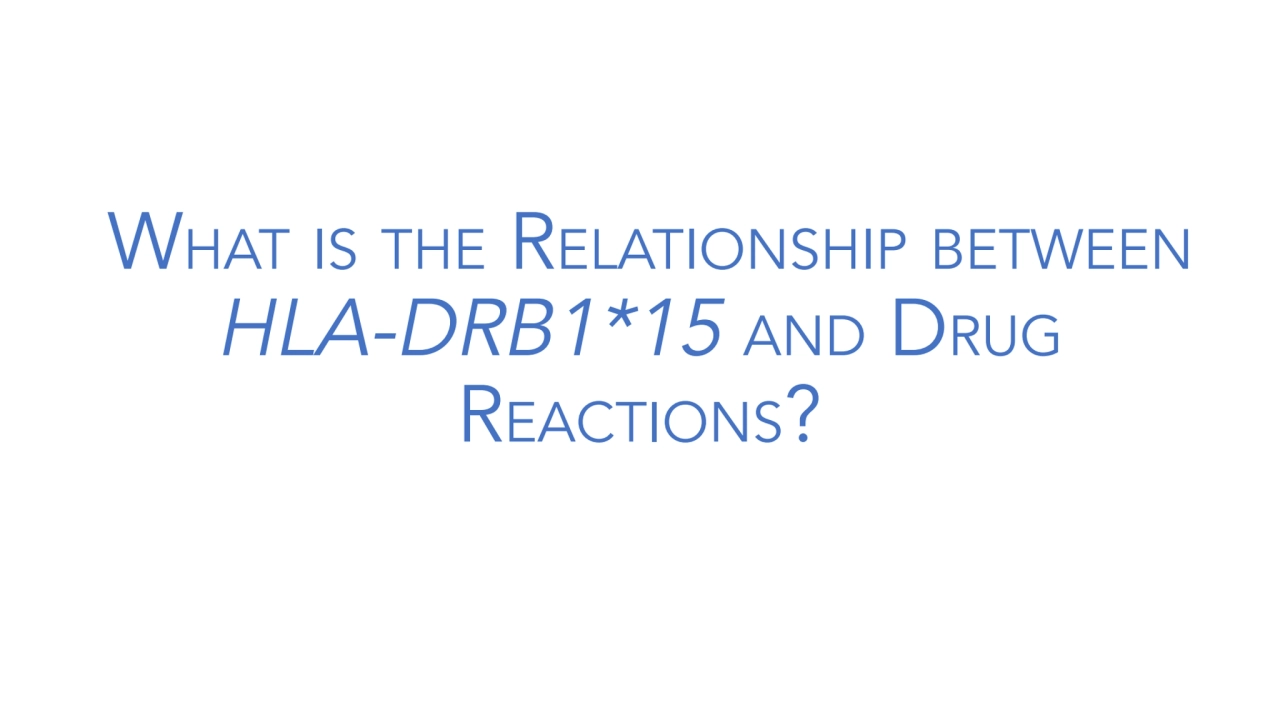
Loading...
![DRUG REACTIONS IN STILL’S DISEASE ASSOCIATE
WITH HLA-DRB1*15 ALLELES
1. Drug reaction carriage of HLA-DRB1*15 = 82%
2. Drug reaction, no LD (n=18) vs. INCHARGE sJIA
• HLA-DRB1*15 had an OR 11.0 [4, 30.1]
3. Still’s with drug reaction (n=65) vs. “drug
tolerant” sJIA (n=31)
• HLA-DRB1*15 had an OR 54.9 [11.6, 261]
Saper VS et al, 2022 Ann Rheum Dis
Unique combination of immediate and delayed-type reactions](https://d2z384uprhdr6y.cloudfront.net/bPaL8Nc-mJE4vhdjCj9m4OJg4oBVU2gsW2XO4eumhjQ/rt:fill/q:100/w:1280/h:0/gravity:sm/czM6Ly9qYXVudC1wcm9kdWN0aW9uLXVwbG9hZHMvMjAyNC8xMi8wNS80MzczM2Y2NS04NzFlLTQzZjctYjFjYy1hYTBhYjkyYWQ2YWUvc2xpZGVfMTUtbC53ZWJw.webp)
Loading...
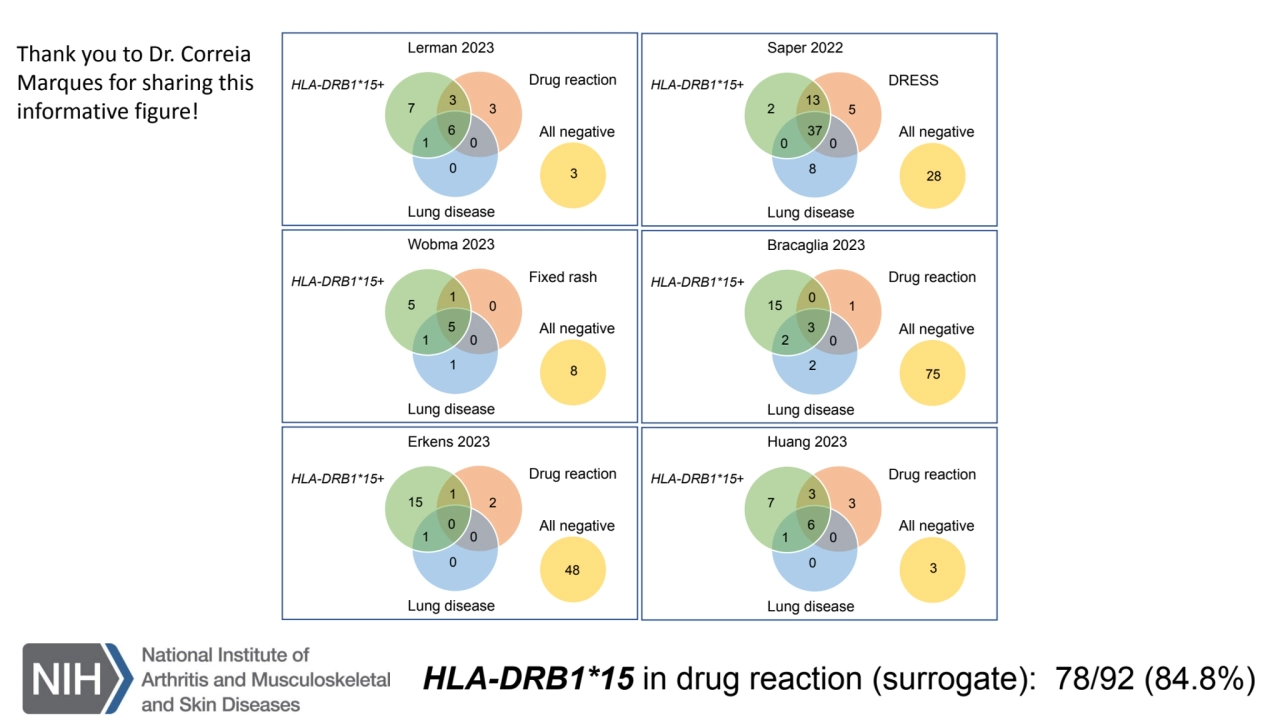
Loading...
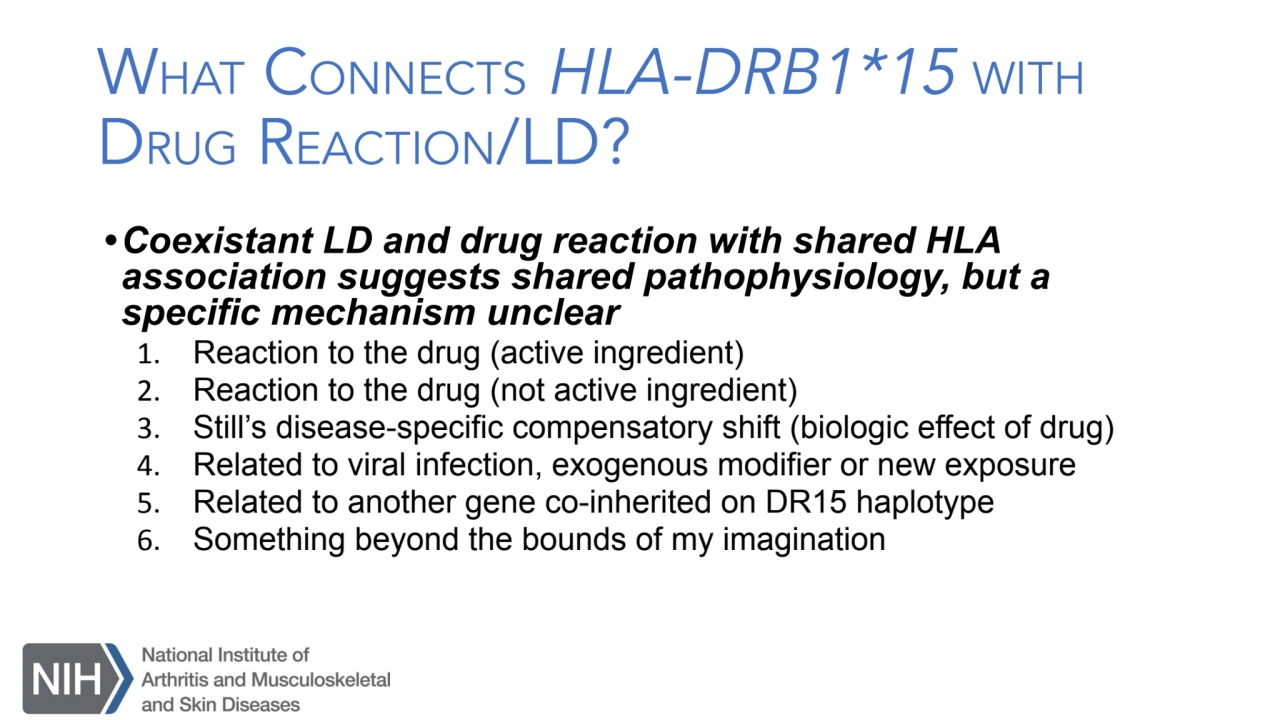
Loading...
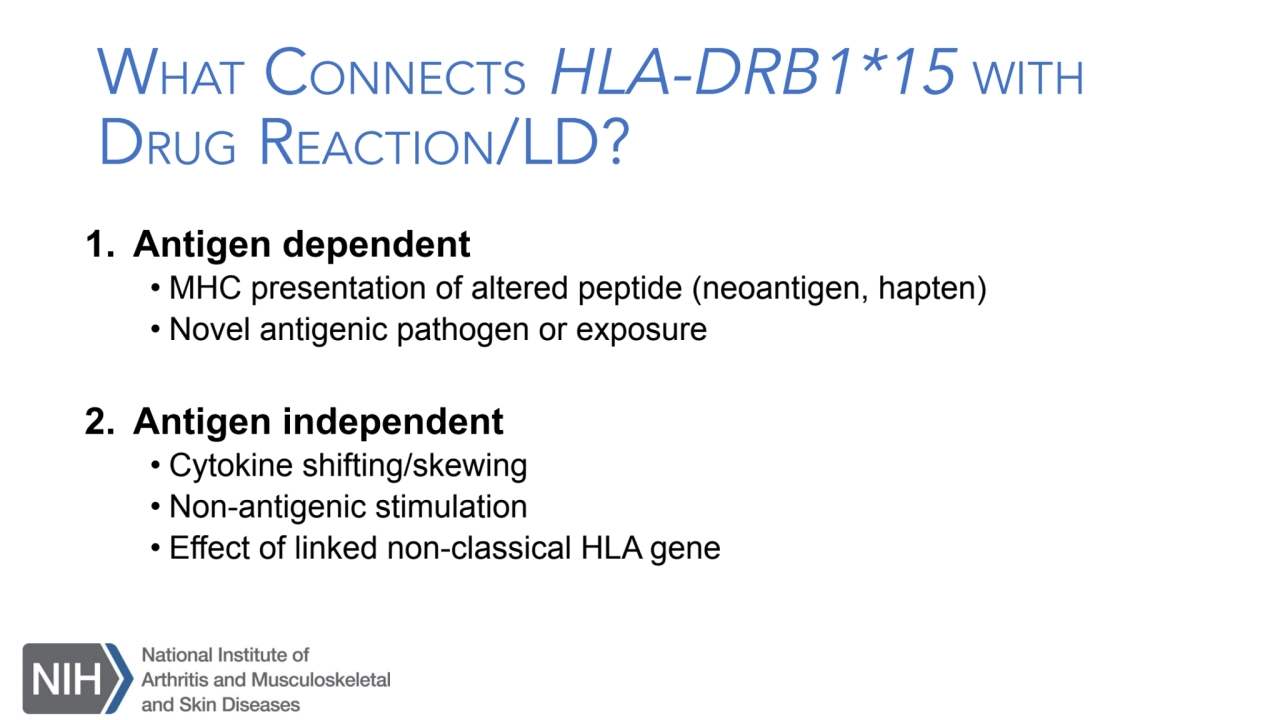
Loading...
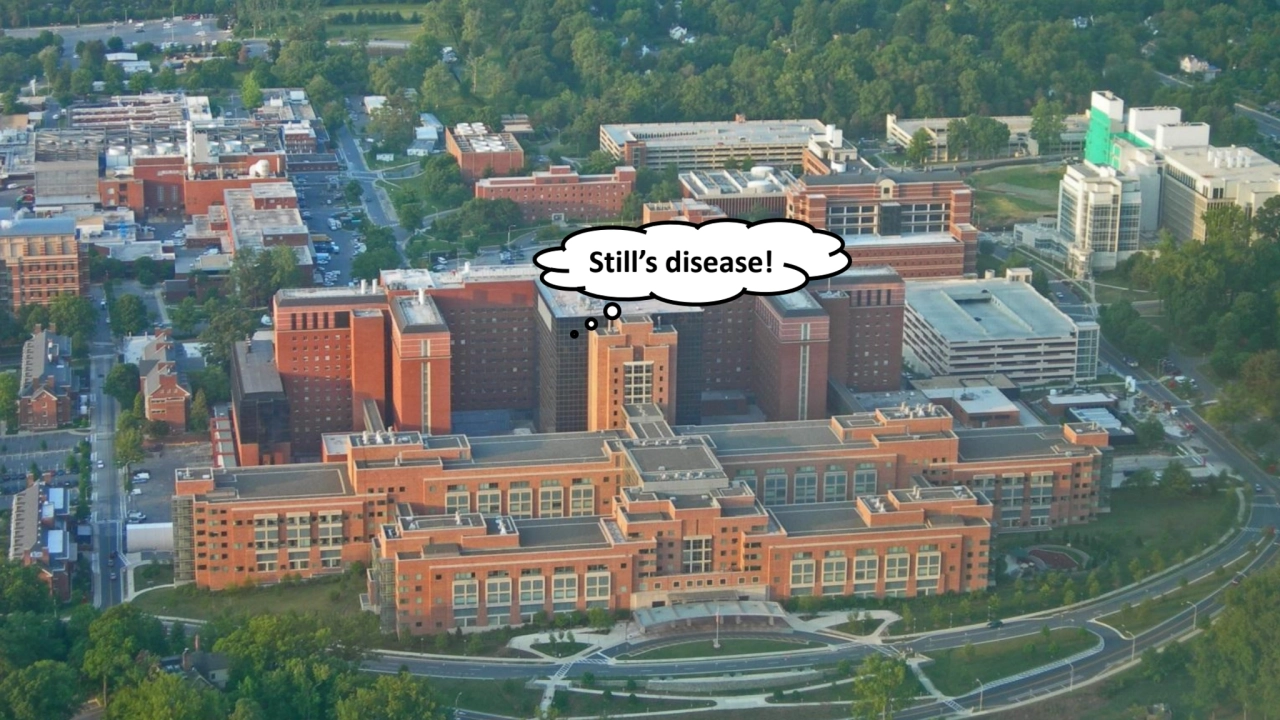
Loading...
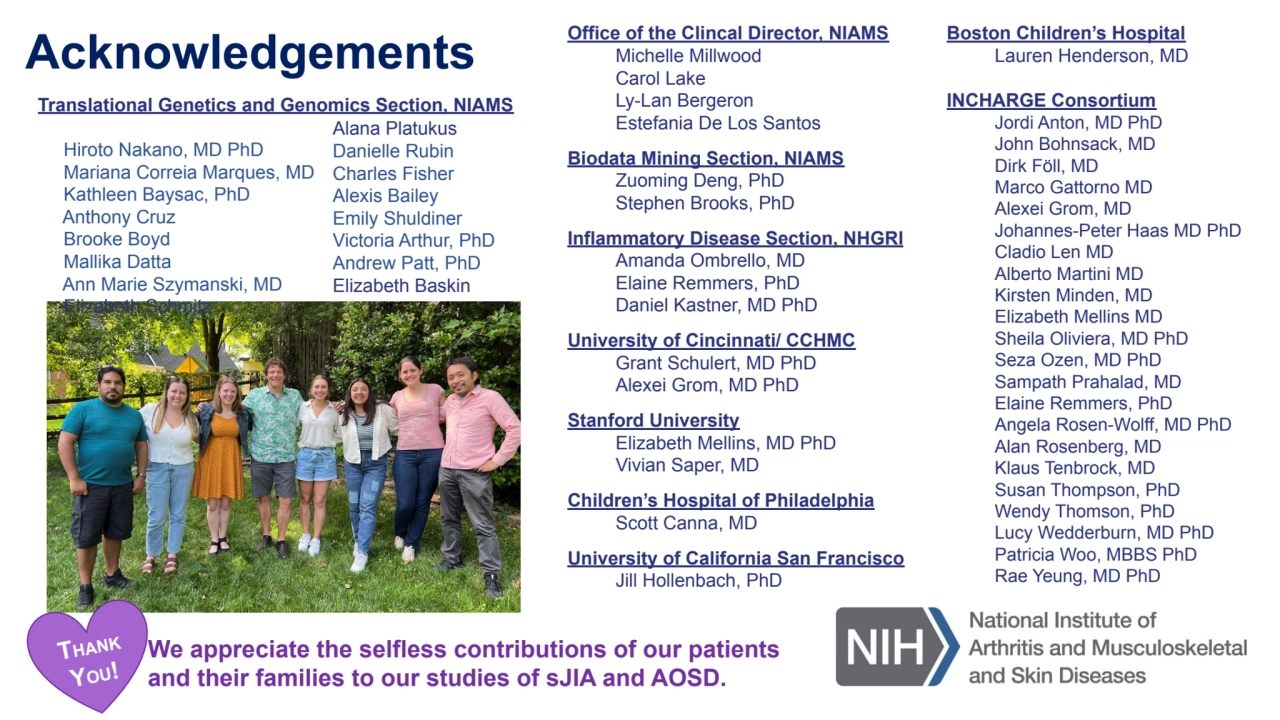
NextGen 2024: Genetics in SJIA Session Part 3
- 1. What is the role of HLA-DRB1*15 in Still’s disease Michael Ombrello Translational Genetics and Genomics Section NIAMS Intramural Research Program
- 2. DISCLOSURES •No conflicts of interest
- 3. WHAT ARE HUMAN LEUKOCYTE ANTIGEN (HLA) PROTEINS?
- 4. WHAT ARE HUMAN LEUKOCYTE ANTIGEN (HLA) PROTEINS? A family of proteins expressed on the surface of antigen presenting cells to display protein fragments (peptides or antigens) in a standardized way that enables T cell surveillance Created with BioRender.com Sakaue S et al, 2024, PMID 37495751
- 5. WHAT IS HLA-DRB1*15?
- 6. WHAT IS HLA-DRB1*15? • A common class II HLA allele group • IE. HLA-DRB1*15:01, *15:02, *15:03, etc. • Common Eurasian ancestral haplotype • DR15 (DRB1*15:01 + DRB5*01:01) • DQ6 (DQA1*01:02 + DQB1*06:02) • Cw7-B7 (C*07:02 + B*07:02) • Immunologically relevant • Strongest genetic risk factor for MS • RA, SLE, narcolepsy and Goodpasture disease • ABPA, egg allergy, ragweed • Altered immunity against EBV ~100 genes ~20 genes 50-66% of DR15 90% of DR15 Sakaue S et al, 2024, PMID 37495751 Hillert J et al, 1993, PMID 8093808 Goodin DS et al, 2018, PMID 29438392
- 7. WHAT IS THE RELATIONSHIP BETWEEN HLA-DRB1*15 AND SYSTEMIC JIA?
- 8. HLA-DRB1*15 ALLELES ARE NOT ASSOCIATED WITH SJIA Ombrello MJ et al, 2015 (PMID 26598658) 9 independent case-control populations
- 9. HLA-DRB1*15 DOES NOT ASSOCIATE WITH SJIA IN IMMUNOCHIP STUDY Unpublished Data Both of these studies were stringently controlled for ancestry at a genetic level
- 10. HLA-DRB1*15 CARRIAGE VARIES BY GEOGRAPHY AND ANCESTRY • HLA-DRB1*15 carriage rates • Myanmar 41-84% • China 23-27% • Europe 20-40% • South American 0-25% • USA • Asian 41% • African American 23-30% • European 29% • Hispanic 20% allelefrequencies.net/hla6004a.asp?all_name=DRB1*15 Eupedia.com/genetics/HLA-DR_distribution_maps.shtml Wobma 🡪 0.49 in sJIA Lerman 🡪 0.74 in sJIA
- 11. WHAT IS THE RELATIONSHIP BETWEEN HLA-DRB1*15 AND STILL’S-LUNG DISEASE?
- 12. STILL’S-LUNG DISEASE IS ASSOCIATED WITH HLA-DRB1*15 ALLELES 1. Still’s-LD carriage of HLA-DRB1*15 = 82% 2. Still’s-LD (n=47) vs. INCHARGE sJIA • HLA-DRB1*15 had an OR of 14.1 [6.4, 31] 3. Still’s-LD (n=47) vs. “drug tolerant” sJIA (n=31) • HLA-DRB1*15 had an OR 57.6 [11.5, 288] Saper VS et al, 2022 Ann Rheum Dis
- 13. 3 6 1 0 0 7 3 Lerman 2023 Drug reaction Lung disease HLA-DRB1*15+ All negative 3 1 5 1 0 1 5 0 Wobma 2023 Fixed rash Lung disease HLA-DRB1*15+ All negative 8 1 0 1 0 0 15 2 Erkens 2023 Drug reaction Lung disease HLA-DRB1*15+ All negative 48 13 37 0 0 8 2 5 Saper 2022 DRESS Lung disease HLA-DRB1*15+ All negative 28 0 3 2 0 2 15 1 Bracaglia 2023 Drug reaction Lung disease HLA-DRB1*15+ All negative 75 3 6 1 0 0 7 3 Huang 2023 Drug reaction Lung disease HLA-DRB1*15+ All negative 3 HLA-DRB1*15 in Lung Disease: 77/92 (83.7%) Thank you to Dr. Correia Marques for sharing this informative figure!
- 14. WHAT IS THE RELATIONSHIP BETWEEN HLA-DRB1*15 AND DRUG REACTIONS?
- 15. DRUG REACTIONS IN STILL’S DISEASE ASSOCIATE WITH HLA-DRB1*15 ALLELES 1. Drug reaction carriage of HLA-DRB1*15 = 82% 2. Drug reaction, no LD (n=18) vs. INCHARGE sJIA • HLA-DRB1*15 had an OR 11.0 [4, 30.1] 3. Still’s with drug reaction (n=65) vs. “drug tolerant” sJIA (n=31) • HLA-DRB1*15 had an OR 54.9 [11.6, 261] Saper VS et al, 2022 Ann Rheum Dis Unique combination of immediate and delayed-type reactions
- 16. HLA-DRB1*15 in drug reaction (surrogate): 78/92 (84.8%) 3 6 1 0 0 7 3 Lerman 2023 Drug reaction Lung disease HLA-DRB1*15+ All negative 3 1 5 1 0 1 5 0 Wobma 2023 Fixed rash Lung disease HLA-DRB1*15+ All negative 8 1 0 1 0 0 15 2 Erkens 2023 Drug reaction Lung disease HLA-DRB1*15+ All negative 48 13 37 0 0 8 2 5 Saper 2022 DRESS Lung disease HLA-DRB1*15+ All negative 28 0 3 2 0 2 15 1 Bracaglia 2023 Drug reaction Lung disease HLA-DRB1*15+ All negative 75 3 6 1 0 0 7 3 Huang 2023 Drug reaction Lung disease HLA-DRB1*15+ All negative 3 Thank you to Dr. Correia Marques for sharing this informative figure!
- 17. WHAT CONNECTS HLA-DRB1*15 WITH DRUG REACTION/LD? •Coexistant LD and drug reaction with shared HLA association suggests shared pathophysiology, but a specific mechanism unclear 1. Reaction to the drug (active ingredient) 2. Reaction to the drug (not active ingredient) 3. Still’s disease-specific compensatory shift (biologic effect of drug) 4. Related to viral infection, exogenous modifier or new exposure 5. Related to another gene co-inherited on DR15 haplotype 6. Something beyond the bounds of my imagination
- 18. WHAT CONNECTS HLA-DRB1*15 WITH DRUG REACTION/LD? 1. Antigen dependent • MHC presentation of altered peptide (neoantigen, hapten) • Novel antigenic pathogen or exposure 2. Antigen independent • Cytokine shifting/skewing • Non-antigenic stimulation • Effect of linked non-classical HLA gene
- 19. Still’s disease!
- 20. Acknowledgements Translational Genetics and Genomics Section, NIAMS Hiroto Nakano, MD PhD Mariana Correia Marques, MD Kathleen Baysac, PhD Anthony Cruz Brooke Boyd Mallika Datta Ann Marie Szymanski, MD Elizabeth Schmitz Alana Platukus Danielle Rubin Charles Fisher Alexis Bailey Emily Shuldiner Victoria Arthur, PhD Andrew Patt, PhD Elizabeth Baskin Office of the Clincal Director, NIAMS Michelle Millwood Carol Lake Ly-Lan Bergeron Estefania De Los Santos Biodata Mining Section, NIAMS Zuoming Deng, PhD Stephen Brooks, PhD Inflammatory Disease Section, NHGRI Amanda Ombrello, MD Elaine Remmers, PhD Daniel Kastner, MD PhD University of Cincinnati/ CCHMC Grant Schulert, MD PhD Alexei Grom, MD PhD Stanford University Elizabeth Mellins, MD PhD Vivian Saper, MD Children’s Hospital of Philadelphia Scott Canna, MD University of California San Francisco Jill Hollenbach, PhD Boston Children’s Hospital Lauren Henderson, MD INCHARGE Consortium Jordi Anton, MD PhD John Bohnsack, MD Dirk Föll, MD Marco Gattorno MD Alexei Grom, MD Johannes-Peter Haas MD PhD Cladio Len MD Alberto Martini MD Kirsten Minden, MD Elizabeth Mellins MD Sheila Oliviera, MD PhD Seza Ozen, MD PhD Sampath Prahalad, MD Elaine Remmers, PhD Angela Rosen-Wolff, MD PhD Alan Rosenberg, MD Klaus Tenbrock, MD Susan Thompson, PhD Wendy Thomson, PhD Lucy Wedderburn, MD PhD Patricia Woo, MBBS PhD Rae Yeung, MD PhD THANK YOU! We appreciate the selfless contributions of our patients and their families to our studies of sJIA and AOSD.